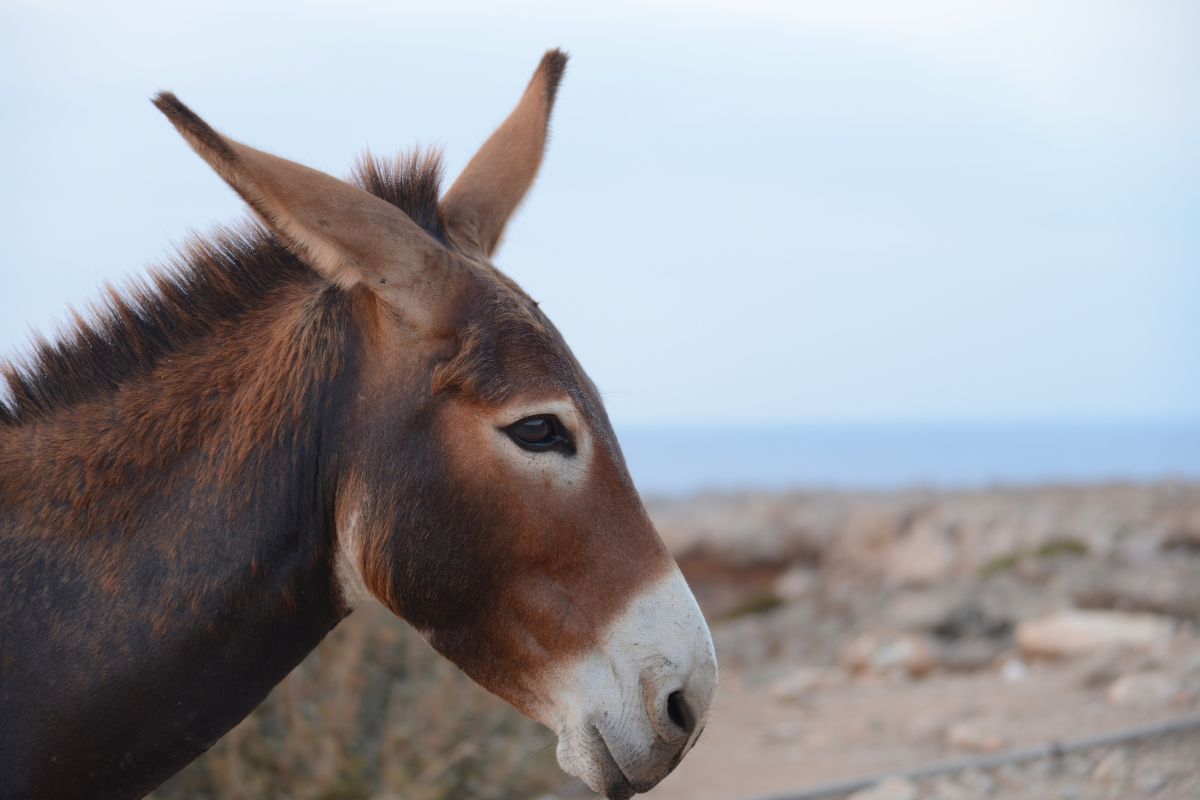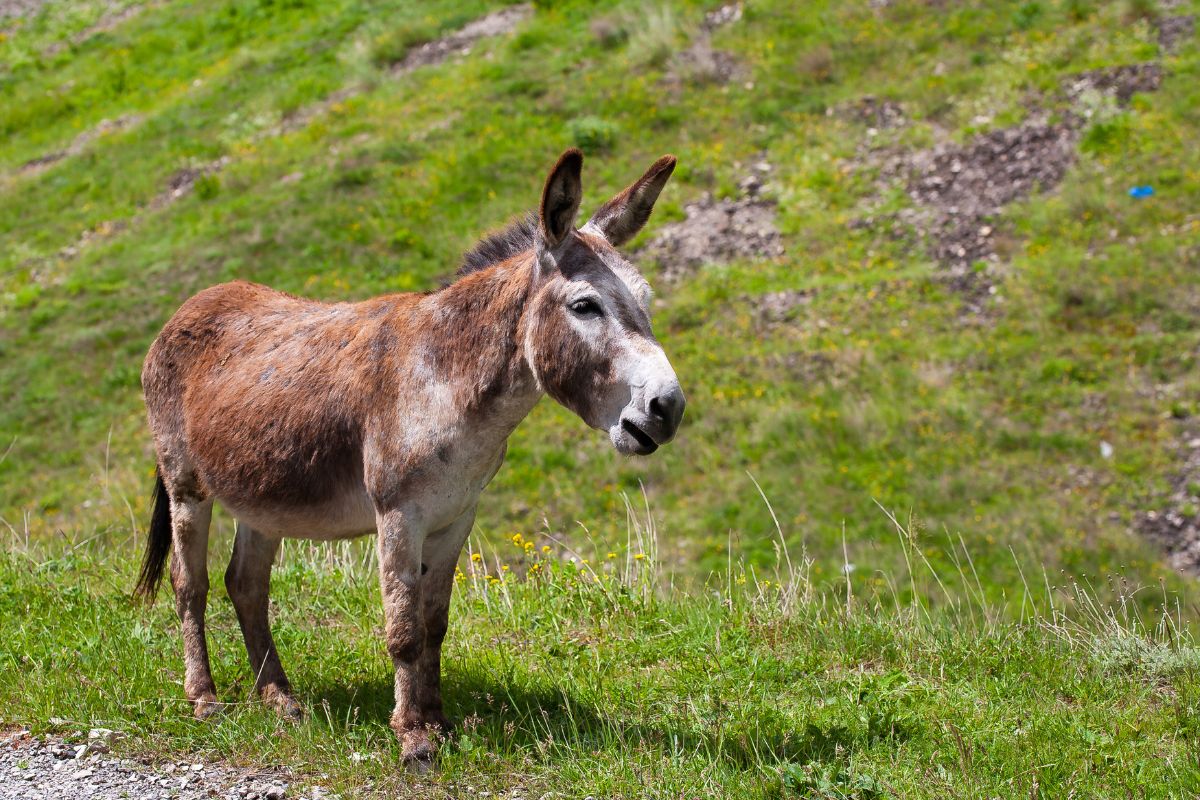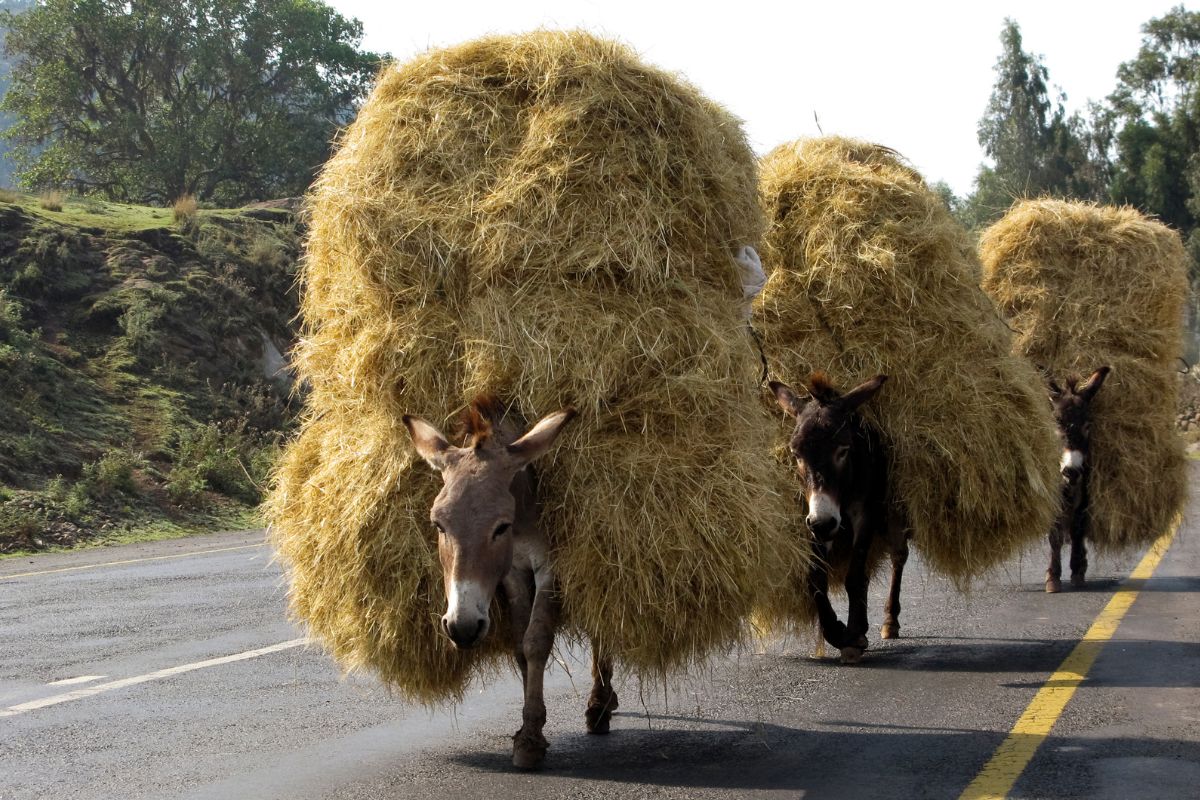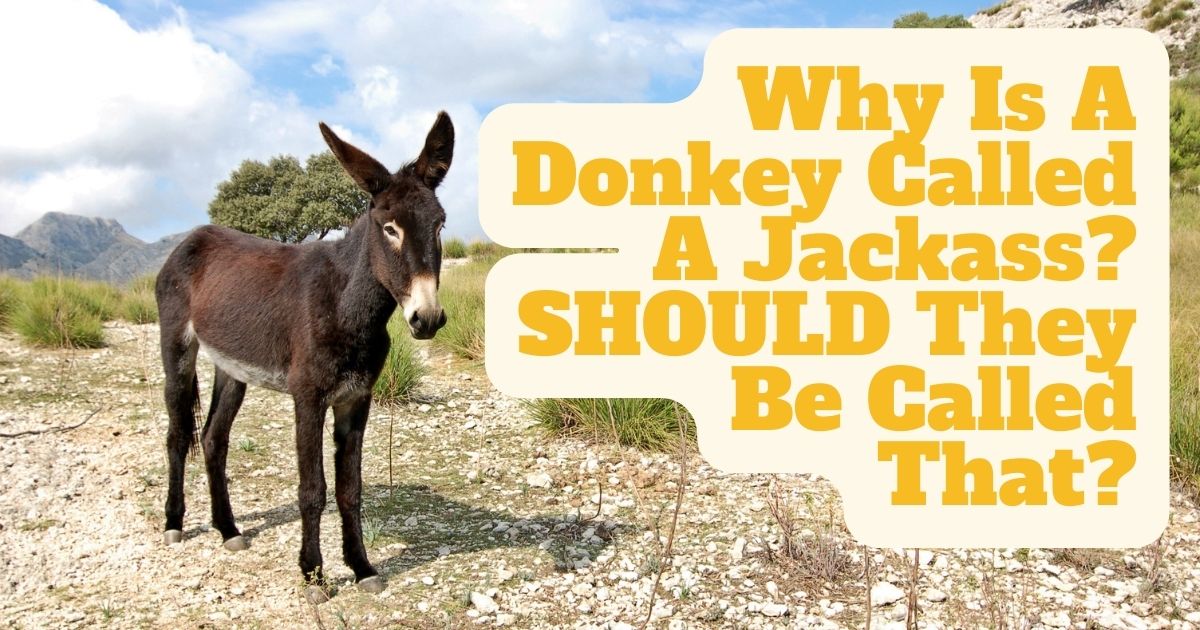What is a Donkey?
You may be wondering, why is a donkey called a jackass? A domesticated horse family member is what we refer to as a donkey. According to Encyclopedia Britannica, domestic donkeys have been transporting things since 4000 B.C.E.
They are a descendant of the African wild ass. Although they have very different dispositions from horses and zebras, donkeys relate to both. Read on to discover why people refer to donkeys as a jackass.

What is a Jackass?
A male donkey is all that a jackass is. The word “ass,” which is from the Latin term “asinus,” which refers to the animal, came before the word “donkey.” While the terms “ass” and “donkey” are synonymous, “jackass” particularly refers to a male donkey.
This combines the male donkey’s nickname “jack” with the traditional donkey slang word “ass.” While pregnant female donkeys are “jennies” or “jennets,” breeding females are “broodmares.”
Why is a Donkey Called a Jackass?
Have you ever had someone tell you not to call a donkey a Jackass? Jackasses can be donkeys, but we cannot label all donkeys as such. The only names we use for male donkeys are Jack, Jackass, ass, and Burros.
Only a handful of these domestic animals get the name Jackass, but people commonly refer to most male donkeys as Jacks. And there is a good explanation behind that. You must first understand the history of the domestic animal to comprehend why just a few donkeys carry the name jackass.
The family Equidae, which also comprises horses, donkeys, and zebras, includes the donkey. These Equidae family members are all stockier and have long, floppy ears. This member of the Equidae family is a wild donkey ass or, to put it another way, a descendent of the African Wild Ass.
The simplest way to characterize the African Wild Ass is as a small, robust animal with a short, dark, erect mane, whitish muzzles, and short, smooth color. The only difference between donkeys and horses is that donkeys are a little smaller and have slightly longer ears.
Now that the pertinent details are available, let’s return to the subject: why are donkeys referred to as jackasses? Sincerely, there are no absolute laws. Different livestock ranchers have different opinions on why people refer to donkeys as jackasses.
Understand Term Jackass
According to the few farmers that raise cattle, not all donkeys are jackasses, and not all donkeys may be such. Sometimes, we call only the obstinate donkeys jackasses. It is incorrect to label “Jackasses” the donkeys that are simpler to handle. It’s just a name we give to stubborn donkeys.
While some livestock farmers claim that you should refer to a male donkey as a Jackass, this effort gets support from the group of livestock farmers who refer to male donkeys as jackasses for a good reason.
They claim that we refer to male donkeys as “Jack” and female donkeys as “Jenny.” Few livestock owners like calling donkeys “Jackasses” because they are a descendant of African Wild Asses.
So why do female donkeys not have names that sound like the males if male donkeys are Jackasses because they descend from Wild Asses? You should also add an “ass” to the female donkey’s name.
Therefore, all livestock caretakers must either begin referring to only the recalcitrant donkeys as “Jackasses” or consider adding “asses” to the name of the female donkey.
How Long do Donkeys Live?
Donkeys can live for 27 to 40 years on average in the wild. They usually live up to 50 years in good health. Parasite infections or physical problems frequently reduce their lifespans in the wild.
- Donkey lifespan in Ethiopia is nine years, but with the proper care and nutrition, they can live up to 25 years, according to the Canadian Journal of Applied Sciences. A donkey in Mexico often lives for 15 years or so.
- In many parts of the world, donkey owners do not care for female donkeys, sometimes known as Jennies, because they “produce problems and do not operate correctly.” As a result, donkey productivity reduces in areas where the male-to-female ratio is about 4:1.
- As you can see, donkeys may live long lives in the right circumstances. However, a donkey’s longevity shortens due to a lack of food, poor or nonexistent veterinary treatment, and heavy labor demands.
Burro vs. Donkey – The Difference
Equus asinus is the scientific name for a domesticated animal called a donkey. A burro is a wild donkey discovered in Mexico, transported to the United States, and then released.
Definition
Equus asinus is the scientific name for a donkey. A burro is a species of Equus asinus that lives in the wild.
Distribution
The donkey is a widespread animal found on practically every continent. Even though the burro’s range is less widespread now, it still exists in some areas, like Nevada in the United States.
Breeding Season
The donkey has a year-round reproductive season because it is a domestic animal, and people can create favorable environments for year-round reproduction. The wet season, when conditions favor more food for growing young and parents, is when burros breed.
Average Lifespan
The typical lifespan of a donkey is between 40 and 50 years. A burro’s lifespan is only 25 to 30 years on average, in contrast.
Origin
The first domestic donkeys have been in existence about 6000 years ago. The horse, the zebra, and all other members of the family Equidae, including the burro, all first appeared between 4 and 4.5 million years ago.

What is the Difference Between a Donkey and a Jackass?
Here are some additional details that should be the enigma surrounding this odd conduct. Domestic donkeys are also referred to as “asses” in addition to jackasses. It is improper to refer to a domestic donkey as “ass,” as we do with African Wild donkeys.
Although the stubborn donkeys are ancestors of wild asses, livestock keepers don’t mind calling them asses. It’s okay to use the term “ass” when referring to a stubborn donkey. Consequently, you can call a stubborn donkey an ass if you don’t document it.
Donkeys are not called Jackasses or simply asses in Spanish or Mexico. Male donkeys are more commonly referred to as Burros by the Spanish and Mexicans. Spanish for “burros” is “donkey.” The Spanish and Mexicans favor using this name for little donkeys with long hair.
The few names for donkeys include burros, asses, or jackasses, to put it simply.
Officially, terms refer to Jack and Jenny. Female donkeys are Jennies, whereas male donkeys are Jacks. Livestock keepers refer to the male donkeys as burros, asses, and jackasses, among other names.
Can you refer to a donkey as a jackass, then? It is okay to refer to a donkey as a jackass. It is advisable to refer to this domestic animal as “Jack” instead. Jack is the name given to the male donkey in the books and official records.
What is the Scientific Name for a Donkey?
Based on the priority rule for scientific animal names, the donkey’s traditional scientific name is Equus asinus.
The Characteristics of a Donkey
Asses and burros, other names for donkeys, have long been in use as labor and companion animals by humans.
Archaeologists discovered numerous virtually entire donkey skeletons in perfectly preserved Egyptian tombs that date back more than 5,000 years, indicating domestication at that period. Donkeys are still used in transportation, agricultural work, and as pets.
Physical Characteristics
Donkeys are physically distinct from their ancestors in some essential ways. Although some donkeys are larger than certain ponies, donkeys generally weigh less than horses. The length of a donkey’s ear compared to a horse’s ear is one of the major disparities between the two animals.
Horse manes are more like hair in that they are long and flowing rather than rigid and straight like those of donkeys. Additionally, tails differ: Horse tails have long, flowing hair that begins at the base of the rump; the typical human “ponytail” is quite similar to the tail of a horse or pony.
Donkey tails have a short hair covering until the end, which terminates with a brush of longer hair. Most donkey breeds have smooth coats in shades of gray or fawn, but others have distinctive coats, such as the Poitou, which has a black, shaggy coat.
Size Differences
The donkeys range from under 3 feet (0.9 meters) tall to over 14 hands (1.4 meters) and are frequently used to identify them. You measure horses and other equines from the ground to the highest point of the shoulders, often known as the withers, using a hand, a unit of measurement equal to 4 inches (35.6 centimeters).
Small, regular, and huge stock ranges from 36 to 48 inches (91.4 to 121.9 centimeters). Height norms range from 36 to 48 inches (91.4 to 121.9 centimeters). Mammoth jacks and jennets can reach a height of 56 inches (142.2 centimeters).
Behavioral Characteristics
You’re as stubborn as a mule. Mules are only partially ass. The truth is that asses often have amiable personalities that are very helpful to their handlers. In contrast to horses, who often run away from any perceived threat, donkeys and mules are more cautious and steadfast animals.
Most donkeys and mules are kind and loving, and their intellect is useful. Although they are happy to coexist with other farm animals, these herd animals perform best together.
These equines prefer pasture grazing, while pasture or grass hay is a suitable feed, as are formulas with mineralized salt for horses and other equines.
Reproductive and Genetic Traits
Equine reproduction and genetic makeup differ from those of asses. Although they can interbreed, the offspring is virtually always sterile, even between these closely related species. While domestic asses have 62 chromosomes and hybrids have 63, domestic horses have 64.
The mule and the hinny are examples of hybrids. A hinny is the progeny of a jennet, a female donkey, and an intact male horse, while a mule is an offspring of a mare, a female horse, and a jack, or a male donkey. Zebras and donkeys can also breed together.
Jack donkeys have different genitalia than stallions, while jennet donkeys have distinct cycles and gestation times from mares.
What are Donkeys Used For?
Donkeys are essential in farming and transportation in rural regions; they pull carts and plows, transport items to markets, and get water from wells. They are primarily used in construction, transportation of people and commodities, and garbage collection in metropolitan areas.

What Does the Word Donkey Mean?
An ass is a tamed horse-family member with long ears and a braying call employed as a beast of burden: an idiot or an idiot.
Wrapping Things Up
The ancestors of donkeys are African wild asses. There are many reasons why people want and admire a big donkey. You should use a few phrases to distinguish between male and female donkeys.
Officially, female donkeys are Jennies, and male donkeys are Jacks. In addition to Jack, you can refer to male donkeys by a few other names.
The most common one is Jackass. Because of their stubbornness or because they are a descendant of the African Wild Asses, the male donkeys bear the name Jackasses. It’s okay to refer to a donkey as an ass or a jackass, but Jack is preferable.
